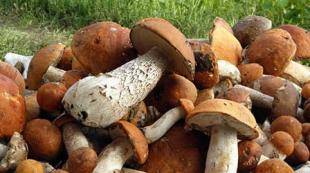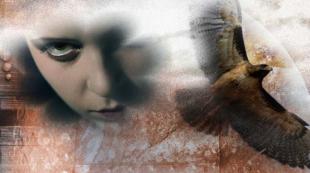Do-it-yourself gypsum vase master class for beginners with a photo and a detailed description of the work. Floor Vase Vase Decoration Ideas
Figured marble vases look very beautiful in the interior, they are self-sufficient and do not need additional decorations with flowers, whether natural or artificial. Therefore, marble vases are very often used as decoration. But the cost of a marble vase is quite high and not everyone can afford such an interior decoration. In the presented master class, I will tell you how to make a plaster vase with the help of gypsum, putty, a bottle and bandages with your own hands and then decorate it with marble.

For work I needed:
- regular 2 liter plastic bottle
- a bag of plaster
- plaster putty
- 2 packs of bandages
- spatulas

On the substrate (I have a piece of drywall), where the vase will be built, I lined a simple plastic bag so that it can be easily removed later. I diluted the gypsum with water, waited until it seized a little and became the consistency of very thick sour cream and laid out a circle 4 cm thick along the diameter of the future gypsum vase. I placed a plastic bottle in the center and began to apply plaster around the edges. It hardens quickly, so you need to work quickly, or dilute it in small portions.

Until the gypsum on the walls of the bottle completely hardened, she wrapped the places of smearing with a layer of bandages, imprinting it into the gypsum. Let it sit for a bit - 20 minutes.

With wet, but already frozen gypsum, you can already work further. I diluted the gypsum putty with water and gradually applied it in thin layers to a bandage wound around the circumference of the vase. Then again a layer of bandage and again a layer of putty. Thus, a blank of the lower part of the vase is obtained. So that later it was easy to remove the bottle from plaster and putty, I did not smear the bottle with a solution up to the neck, but until the bottle narrowed.


Since, according to the idea, a putty vase should be figured and with a neck that gradually expands to the top, it is for this neck that it is necessary to build another frame. I used a simple plastic jar, which I put on top of the lower base of the vase and smeared it with putty, alternating with layers of bandage. It turned out here is such a gypsum blank, which I placed to dry in a warm place for a day.

To make the plaster vase strong, it is necessary to make its walls at least 1-2 cm thick. To do this, after the initial layer has completely dried, I applied several more thin layers of putty, let them dry completely, and then sanded them to a smooth state with sandpaper. The finished version of the plaster vase turned out like this. In the next article, I will talk about how to give a plaster vase the effect of marble, that is, I will make an imitation of marble on a plaster vase.
Today, only lazy people do not improve the design of their home. Fashion trends allow satisfying the most sophisticated tastes of demanding consumers. At the same time, at all times there was a demand for decorating the interior with high floor vases. However, their affordability does not always coincide with the desired appearance. Like any other thing, a floor vase can be made by hand. Such a beauty will be in the desired shape, and in the desired color scheme, and much cheaper than their store counterparts.
Materials for work:
Glass jar with a capacity of 3 liters - 2 pcs.;
Tea saucer - 1 pc.;
Plastic container from preserves - 1 pc.;
Silicone sealant - 1 bottle;
PVA glue liquid (construction) - 1 liter;
Building alabaster - 4 tablespoons;
Potato starch - 100 gr.;
Egg lattices - 4 pcs.;
Vegetable oil - 1 tbsp;
Vaseline - 1 tbsp;
Three-layer napkins - 2 pcs.;
Plasticine - 1 box;
Old tube of PVA glue with a narrow nose - 1 pc.;
Glue "liquid nails", white and "gold" paints, blush, eye shadow, face powder, brush, colorless acrylic varnish, water.
Stages of work:
The first stage: we form the basis.
We turn one jar upside down and glue “liquid nails” to it a tea saucer turned upside down.
Glue the bottom of the second can to the bottom of the same can.

Cut off the bottom of the canning container. We glue the inverted container to the neck of the second jar.

Let the base dry for 1 day.

The second stage: we give the vase the outline of the vessel.
Finely chop the egg racks.

Fill with water so that the entire torn mass is immersed in it. We leave for the night.

We wring out the soaked grids.

Tear off large pieces. Fill the whole mass with PVA glue.

Thoroughly, until a homogeneous gruel is obtained, mix the soaked grates.

We fill the space between the neck of the jar and the container with the egg mass.

Apply a thin layer of egg mass over the entire surface of the jars.

We dry the base for 2 days.

We paint white.

The third stage: we apply a three-dimensional drawing.
Print your favorite stencil.

We make cuts along the contours, cut out the necessary points.


We place the drawing on the vessel in a checkerboard pattern in a straight and inverted form (2 times above, 2 times below; top and bottom facing each other).


Draw voids and cuts with a pencil.


Squeeze silicone sealant into an empty PVA tube.

We put a sharp nose on the tube and squeeze the sealant along the contour of the picture.

If necessary, make adjustments with a toothpick.


Dry the sealant for 1 day.

With superficial movements with a large brush, we apply blush toning on the drawing.


Fourth step: make a silicone mold.
Mix potato starch and silicone sealant.


Thoroughly knead until a pasty mass is obtained.

We coat the surface of the figure blank (in this case, a magnet) with Vaseline.

Press the pastry into the flattened dough with the right side down.


Carefully prying with a knife, we take out the workpiece.

Fifth stage: casting the figures.
Lubricate the inside of the silicone mold with vegetable oil (pour it in, then turn the mold over and pour out the oil).

Pour a tablespoon of alabaster (or gypsum) into the container.

Add a spoonful of water there, mix. If the solution becomes thick, add water.

We fill the silicone mold with alabaster solution.


We leave the solution to harden (you can check the readiness by pressing the nail on the figure - the trace should not remain on the surface). We pry the figure with a knife and take it out of the mold.

We repeat the preparation of the solution and pouring 3 more times.

Sixth stage: paint the angels.
We paint over the blanks with white gouache.

The bodies of the angels are matted with face powder.

We dye our hair.

We draw sponges.

Draw the eyelids and eyebrows with a pen.

With white gouache we close the extra layer of powder (next to the bodies of the angels).

Draw the wings in gold.

We apply “liquid nails” on the back surface of the figurines and glue them on the vase.


Step 7: Make roses.
We knead the plasticine, lay it on a hard surface with a thin plate, cut it into squares. In each square we make cuts in a circle from the center.


Gently prying the central center, twist the spiral, moving from the center to the edge. We bend the square corners like large leaves.


We paint the roses white.

We tint them with blush in the color of the volumetric pattern.

The edges are gilded.

"Liquid nails" fasten the roses to the vase.


Master classes that teach how to make gypsum vases with your own hands will help to add a twist to the design of your home or prepare an original gift for a loved one. First, it's pretty simple. And secondly, you can create gypsum vases with your own hands according to your own design. And then you get an absolutely exclusive thing.
This manufacturing option is the simplest. The master will need a piece of unnecessary matter. Immediately before work, a gypsum solution should be prepared.
The fabric is dipped into it and hung on a bucket, a post, a stump. It is only important to think in advance that the bottom of a do-it-yourself gypsum vase should be stable and even. Therefore, it is recommended to fill something on the upper part of the column of small thickness that increases the diameter of the base of the future craft: a plate, a pot lid with the handle down, a cut out square or circle made of plastic or wood.

In a few hours, a rather creative plaster vase will be ready. It is not at all difficult to make it with your own hands.
Gypsum vases from improvised materials
Most often, masters, working with gypsum, use the casting method. In order to make a vase from plaster with your own hands using this technique, you need to choose the right shape. It is not necessary to prepare the mold specially. You can find something suitable among improvised materials.
For work, use the main container of the desired size. It can be a plastic or glass bottle, a box, a container, a tall beer glass.

It is also necessary to take care of the detail, thanks to which it will be possible to make a recess inside the vase. It can be of any shape. Only here the master needs to pay attention to its size: too large can lead to the fact that the walls of the vase will turn out to be too thin.
If a figured mold with a narrow neck is used for casting, for example, a bottle, plastic or glass, then after the gypsum has hardened, it will not be so easy to remove the craft. Plastic can be cut and removed. And glass containers will have to be carefully split so as not to damage the gypsum vase made by oneself.
Master Class
Here, the technique of casting a vase with a rectangular base is considered in detail.
To make it, you will need a container: a milk or juice box, a container, a box, a box. It is important to choose the right size shape. In this case, a plastic container for storing cereals is used.
It is also worth taking care of the details for the recess. It is convenient to take a glass or a glass bottle, with a diameter smaller than the pouring mold.

- The part to be removed is placed in a larger container. She is held in such a way that she does not touch the bottom of the mold.
- Gypsum diluted with water is carefully poured into the void between the mold and the part to form a recess.
- Then you should wait a while for the plaster to harden slightly. During this period, the part of the recess is kept suspended.
- When the mass "grabs", the structure is left until it hardens completely. Then the vase is taken out, the irregularities are polished with fine sandpaper.

You can leave the vase white - it's very stylish. But if the master has a desire to paint the craft, make a drawing on it, then you should not resist him. The finished vase can be varnished.
Making molds for casting
Often you want to make a vase of a certain shape or repeat an already finished one. Then the master himself makes a mold for casting from a solution of gypsum or silicone sealant.

- A slightly larger container is taken than the object from which the form is removed. She will act as a formwork.
- A mass (gypsum mortar or silicone sealant) is poured onto the bottom of the container.
- After hardening, the object itself is laid sideways on the resulting layer.
- The mass is filled exactly to half.
- The structure is left alone for a while.
- It is possible to make recesses in the not yet completely hardened mass. These will be the “locks”, thanks to which the parts of the mold will precisely fit together during the casting of the vase itself.
- Next, the structure should completely harden. This will be one part of the mold. You can check if everything turned out right at this stage by removing the template from half of the mold. Then the demoulding specimen needs to be put back in place.
- The top layer of half of the form is greased: glycerin, petroleum jelly, oil, cream.
- Fill the entire template with mass so that it disappears completely.
- Wait until the mass becomes as solid as possible.
- The halves of the mold are taken out of the container, separated from the template from which the mold was removed.
Gypsum floor vases
Now you can start casting. With the help of such molds, do-it-yourself gypsum floor vases are made.
First, the halves of the form are connected and fixed by wrapping them with string, tape, and electrical tape. The filling principle is similar to that described in the "Master Class" chapter.

The resulting craft is covered with paint, varnish or a drawing is applied. If desired, the vase is left white.
Creative Lego molds
You can create your own vase design. For example, a layout is assembled from Lego parts.

Do you think that only professionals can work with such a fragile and quickly hardening material? You are deeply mistaken, because now you will see one way with which you can make gypsum vases with your own hands in a short period of time. To do this, you do not need to purchase an expensive segment, but you will have to carefully carry out all the stages of work. The main thing is patience and a little skill.
And you will also have to visit last year's field, where ears of wheat or oats grew. Do you think that there is nothing after the snow? In vain! After the descent of the water, so many interesting things can be found! Moreover, this forbs will be needed to create a surprisingly beautiful relief on the future piece of furniture.
Do-it-yourself gypsum vases: what to buy?
We go to the store for:
- plasticine - 2 boxes, one color can be;
- paraffin candles (2 pcs);
- liquid soap - 20 gr;
- lemonade / juice / milk in a low bottle with an average neck - 1 pc;
- gypsum (dry) - 0.5 - 1 kg;
- cling film or plastic bag;
- cotton material.
Do-it-yourself plaster vase: we are working!
From plasticine we roll out 5 plump layers (large 2, a little less also 2, an oval for the bottom 1).
We lubricate one side with soap and put what we found on the field on the damp wall, pressing it in so that the contour of the edge is clearly visible.

We remove plants.

We collect plastic blanks in a vase and pinch the ribs well: do not be afraid to make the pinches thick, the main thing is that the diluted gypsum does not leak out and does not deform the blank. Flora prints should be inside.

We wrap the bottle with material, on top of it with cling film in 5-6 layers.

We send the container to the bottom, clearly in the center.
Continuation of the "banquet"
- Gypsum is diluted according to the instructions for it.
- Fill up to half, holding the bottle.
- As soon as the solution begins to solidify - top up to the brim.
- Hardening time - look at the plaster package, but you won’t find it, so don’t touch the form for 3 hours.
- We take out the bottle and leave it for another 2 hours.
- We remove the plasticine and get the finished product.

Decor technique for a vase made of plaster "Old stone"
Let's try to master the technique of the "old stone".
- You put on rubber gloves.
- Distribute bituminous wax on the surface of the walls with a brush.
- We remove the rest with a napkin.
- Take some baby powder and sprinkle it on the surface.
- With a new dry brush, spread over the surface so that the talc gets into each depression.
- Melt the candles.
- Use a brush to apply it to the surface of the vase.
- Let dry and polish with a soft cloth.

The talc in the wax will age the surface, so you get an amazing piece of furniture that you can put in a prominent place.
A creative person rarely sits idle. He devotes most of his free time to needlework. And if he wants to make, say, a vase from improvised materials, he gets down to business with inspiration. It would seem that such manufacturing is associated with a lot of difficulties and knowledge of the intricacies of the process. However, the material in this article will show how much easier the implementation is in reality than it might seem at first glance.



Nuances
The operation of a do-it-yourself vase will depend on the materials for its manufacture. For example, if they withstand moisture, you can put fresh flowers in them. Options that involve the use of products (such as cut lemon wedges or small multi-colored candies) are themed for some kind of party or event.
As a rule, such vases are created to decorate a festive table, as well as the room as a whole.
Sweets are also used instead of orbis, such vases look stylish, fresh and spectacular. With a minimum of manufacturing costs and the selection of the right stylistic solution, crafts can hint at a certain idea of \u200b\u200bthe existing style.



And if you think over the manufacturing technology, such vases can even be used for beautiful summer and romantic bouquets. And after all, everything ingenious is really simple: to reduce the number of sweets used and be able to pour water inside, it is enough to put another narrow one in the vase.
Some create a jar or a bottle of paper circles twisted into rolls. Of course, this is rather just a decorative product, however, it will look harmonious in the interior of the home.
Such decor always attracts attention, it stands out against the general background of the interior space.



Plaster and clay vase
The technique for making such a vase is special, since clay products need to be fired. Gypsum, on the other hand, is a material that is unstable to moisture, so such a vase can only be used for dried flowers. To make a plaster vase, you will need:
- juice carton;
- gypsum;
- brushes;
- lace ribbon;
- cup.



Before starting work, cover the work area with plastic wrap, since regardless of the accuracy of the work, it will be dirty, and it will be easier to remove the finished vase from the film. Gypsum is kneaded, diluted with water, achieving a creamy density and uniformity of the mixture. The box is cut off from above, aligning the edge. Gypsum is poured into it, and until it hardens, a glass is placed there, setting it strictly in the center.
The vase is left to dry completely, after which it is taken out of the box and disposed of the glass. The surface is sanded with fine sandpaper. After that, a lace ribbon is attached to the front surface, trying to do it as tightly as possible to the plaster. Further, over the entire area, the vase is covered with paint using a spray.
After the structure dries, the lace is removed, you can silver some elements or not touch them at all.



Making from a glass jar
It is easy to make such a product with your own hands. For this, even a piece of burlap, a rough rope rope, a music notebook and beautiful shiny fittings can come in handy. The required amount is cut from a piece of canvas, measuring the length and width along the central diameter of the can. The jar is wrapped with a cloth, fixing in two places with special glue.
20-30 petals of the same size are cut out of a musical notebook and a flower is formed from them. For the middle, shiny round-shaped fittings are used. The resulting flower is glued to the junction of the linen fabric, closing the joint.
A rope thread is tied to the neck of the jar, tying it with a small bow.



From paper modules
You will have to spend more time on crafts using the origami technique, since you first need to prepare all the necessary module elements, from which the product will be assembled according to the scheme in the future. It is easy to assemble the parts using the triangular modules shown in the photo. It is necessary to prepare such elements 433 white and 211 yellow. The first row is formed into a circle of 20 white elements, when combined with 20 yellow ones, the second row is obtained.
For the third row, they take yellow ones (20 pcs.) And turn the resulting circle in the other direction. By inserting 30 yellow elements into the pockets of the third row, they form the fourth row.



To be able to increase it by 10 pieces, the first of them is put on in the usual way, and the adjacent pockets of the second and third are left empty. Next, modules of subsequent rows (from 5 to 16) are attached, using 30 elements for each row and taking into account the selected tone scheme.
After the 16th row is completed, the 17th is made white, and then on the 18th the modules are put on backwards in relation to the previous row. The penultimate row is the top of the vase, it needs 40 modules, which are put on the previous elements, evenly adding 10 pieces per circle. The last row is performed a little differently: one corner of the module is inserted into the left pocket of the second module, the right one is inserted into the gap between the elements of the previous row.
The bottom can be made from modules or ordinary thick cardboard. If desired, you can add handles to the vase.



From a bottle
Even ordinary rope thread can be used to make a vase based on a bottle. She wraps the product in a circle, trying to lay the thread as tightly as possible to the glued base of the bottle. Glue must be applied special, and there should not be much of it, as this may affect the appearance (glue should not show through the thread).
You can use this product for decorative artificial flowers. If you want to be creative, you can even decorate the product with ordinary buttons or the same thread, having previously dyed it in a contrasting color so that it contrasts with the background of the main material.



Papier mache
Making a papier-mâché vase at home is easy if you follow the step-by-step instructions. Inside it, you can leave a jar or a bottle, which will make the product not only decorative, but also functional. You will need a form, old newspapers, white paper, PVA glue, stationery brushes, cling film, varnish and gouache.
- The form is wrapped with cling film from the outside.
- Glue is mixed with water in a ratio of 1: 2, the newspaper is torn into pieces and placed in an adhesive solution for impregnation.
- The prepared material is tightly pasted over the outer area of the mold, covering it with several layers with drying of each previous one. At the same time, the form is pasted over to the limits of the decrease in its diameter at the top, so that in the future it would be easy to remove papier-mâché.
- After several layers of newspaper are glued and dried, the product is pasted over with white paper, dried and removed from the mold.
- You can make another layer of white paper and leave the future vase to dry for about a day.
- Then it is covered first with gouache, and then with varnish.


From a tall glass
If you have acrylic paint, modeling gel and glitter at home, creating a unique vase from an ordinary long glass will not be difficult. The manufacture of such a product will take a minimum of time, however, accuracy will be required: first, it is important to evenly glue tape of small width to the glass surface at regular intervals.
Using a sponge, a modeling gel mixed with glitter and paint is applied to the exposed surface. As soon as the paint is applied, the strips of adhesive tape are immediately removed, because it will be problematic to do this later (it can grab onto the gel).
The paint is applied in a thin layer, if desired, the vase can be decorated with small half-shaped beads.


From a tire
Tire vases are often used as garden beds. These are large decorative and, at the same time, functional products for fresh flowers and greenery. Someone simply paints the tire and decorates it, considering this option to be sufficient. Others prepare a product diagram with a stand and proceed to cut the tire. It is cut with a knife, cutting out the outline of the desired pattern.
In order to simplify the cutting process, the knife is periodically dipped in a soapy solution. After the tire is cut from one side, the rubber is wrapped to the other side.
If desired, such a vase can be painted, giving it a more aesthetic appearance. Use such products for decorating the landscape.



Decor of the finished product
The master, who has his own view on the use of different objects, almost always produces a spectacular product. And different “accessories” can be used, for example:
- dry branches and saw cuts of a tree;
- shells of various shapes and sizes;
- twine and cotton thread;
- wooden buttons and half beads;
- decor made of metal and plastic;
- foil and kraft paper;
- colored pencils and contour paints;
- spray dyes and beads;
- satin and organza ribbons;
- decoupage napkins and acrylic glue;
- lace braid and fabric with a relief texture;
- corrugated and crepe paper;
- self-adhesive decor and torn pieces of newspaper.

Someone uses stained glass paints to decorate homemade vases, creating unique images on the surface of ordinary glass bottles and jars of various sizes. In this case, often the finished vase is not only beautiful. It is unique, and when taking into account related tones, it successfully merges into the existing interior environment. Others like eco-decor, so they embody it, sometimes using deliberately crooked branches, placing them close to each other or, on the contrary, intertwining them.
Someone takes an ordinary vase and focuses on interior decor. For example, in one case, the most common glass object is filled with branches, orbizes. Sometimes paint is poured into the bottom and stretched, turning the container at different angles, forming waves of different heights. Someone likes to give the original texture to the vase.



For example, for this, you can draw a relief pattern with a special composition, which, upon further painting, will give a unique vase relief.
Others prefer to use beautiful openwork lace. For example, such decoration is performed when products are made of gypsum or concrete. Until the mass has hardened, a pattern is formed by slightly pressing the lace to the base of the flowerpots. Shells are simply pressed in and then covered with paint or left as is. Someone uses mosaics to decorate floor vases, as well as broken pieces of mirrors or wall tiles (it is thinner than analogues for the floor). However, their laying is laborious and requires maintaining an identical distance between all elements, which is difficult for a beginner.









